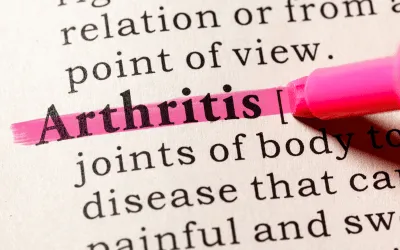About Arthritis
As the nation’s #1 cause of disability, arthritis affects nearly 60 million adults and 300,000 children. Over 100 types of arthritis and related conditions damage the joints and often other organs.
How can we assist you?
Helpful Tools for You

The Hidden Triggers: How Your Daily Habits Can Make or Break Your Arthritis
What Your Doctor May Not Have Told You About Arthritis
If you're living with arthritis, you've probably heard the standard advice: take your medication, stay active, and manage your weight. But what if we told you that simple changes to your daily routine – from the foods you eat to how you handle stress – could have a profound impact on your arthritis symptoms?
Recent research in 2025 has revealed fascinating connections between our lifestyle choices and arthritis flare-ups. The good news? Many of these factors are completely within your control. Understanding these hidden triggers and helpers can be the key to taking charge of your arthritis management.
The Surprising Truth About Arthritis and Lifestyle
Arthritis isn't just about aging joints or genetics. Modern research shows that multiple lifestyle factors work together to either increase inflammation in your body or help calm it down. Think of it like a seesaw – on one side, you have habits that fuel inflammation and worsen symptoms. On the other side, you have choices that can reduce inflammation and provide relief.
The most encouraging finding? Recent research has proved that regular physical activity can reduce the risks of developing rheumatoid arthritis, and lifestyle modifications can help achieve remission from rheumatoid arthritis.
The Food Connection: What You Eat Matters More Than You Think
Foods That Can Trigger Arthritis Flare-ups
Your diet plays a more significant role in arthritis symptoms than many people realize. When you have arthritis, your body is in an inflammatory state, and what you eat may increase inflammation and set you up for other chronic conditions.
The Main Culprits:
1. Processed Sugars and Refined Carbohydrates The American Journal of Clinical Nutrition warns that processed sugars trigger the release of inflammatory messengers called cytokines. This includes:
Desserts, pastries, and candy
Sweetened beverages and sodas
White bread, white rice, and refined pasta
Many breakfast cereals
2. Saturated Fats Several studies have shown that saturated fats trigger fat tissue inflammation, which not only indicates heart disease risk but also worsens arthritis inflammation. The biggest sources in the American diet are:
Pizza and cheese
Processed meats like sausages and deli meats
Fried foods and fast food
3. Omega-6 Fatty Acids (in excess) Excess consumption of omega-6s can trigger the body to produce pro-inflammatory chemicals. These are found in:
Corn, safflower, sunflower, and soy oils
Mayonnaise and many salad dressings
Processed snack foods
4. Additives and Preservatives
MSG (monosodium glutamate) in processed foods
Artificial sweeteners like aspartame
Excessive salt, especially for those taking certain medications
Foods That Fight Inflammation
The Mediterranean diet continues to show remarkable benefits for arthritis management. Scientific research confirms the benefits of a Mediterranean diet on reducing inflammation, with studies showing that those who closely followed this diet had lower levels of inflammatory markers in their blood.
Your Arthritis-Fighting Food Arsenal:
1. Omega-3 Rich Fish Studies show that those who had the highest consumption of omega-3s had lower levels of inflammatory proteins, and fish oil supplements help reduce joint swelling and pain in people with rheumatoid arthritis.
Salmon, sardines, mackerel, and herring
Aim for 3-4 ounces, twice a week
2. Colorful Fruits and Vegetables Research shows that the anthocyanins found in cherries have an anti-inflammatory effect, and they're also found in:
Blueberries, blackberries, and strawberries
Dark leafy greens like spinach and kale
Broccoli (rich in sulforaphane, which may slow osteoarthritis progression)
3. Nuts and Seeds Multiple studies confirm the role of nuts in an anti-inflammatory diet, with one study finding that people who consumed the most nuts had a 51% lower risk of dying from inflammatory disease.
Walnuts, almonds, and pistachios
A small handful daily provides benefits
4. Whole Grains Whole grains lower levels of C-reactive protein (CRP) in the blood, a marker of inflammation associated with rheumatoid arthritis.
Oatmeal, brown rice, and quinoa
Whole-grain bread and cereals
5. Green Tea Green tea is packed with antioxidants that block the production of molecules that cause joint damage in people with rheumatoid arthritis.
Practical Meal Planning Tips
Start Your Day Right:
Choose oatmeal topped with berries and nuts instead of sugary cereals
Try green tea instead of multiple cups of coffee
Lunch and Dinner:
Fill half your plate with colorful vegetables
Choose fish or plant-based proteins twice a week
Use olive oil for cooking instead of processed oils
Smart Snacking:
Keep nuts and fresh fruit handy
Choose whole grain crackers over processed chips
The Stress-Arthritis Connection: Breaking the Vicious Cycle
Why Stress Makes Arthritis Worse
Stress sets off the immune system's inflammatory response, and inflammation is what fuels joint damage in rheumatoid arthritis, lupus, psoriatic arthritis, and other inflammatory forms of the disease.
How Stress Affects Your Arthritis:
Physical Impact:
Stress triggers the release of chemicals that ready you to face challenges, but when this fires repeatedly, the increased muscle tension can amplify your arthritis pain
Chronic stress releases cortisol, which can increase inflammation throughout the body
People with rheumatoid arthritis identified stress as a trigger for disease flare-ups
Emotional Impact:
Constant pain, fatigue, and poor sleep create a vicious cycle where each symptom worsens the others
Stress can affect your motivation to exercise, eat well, or follow treatment plans
Worry about the future can increase anxiety and depression
Proven Stress Management Strategies
1. Mindfulness and Meditation Recent research has proved stress to be a major factor in inducing rheumatoid arthritis, and practicing mindfulness techniques like yoga and meditation can improve outcomes.
Simple Daily Practice:
Start with 5-10 minutes of deep breathing each morning
Use smartphone apps for guided meditation
Practice being present during daily activities like eating or walking
2. Regular Exercise When you walk, swim, or do other aerobic activities, your body releases feel-good chemicals called endorphins that boost your mood and combat depression and anxiety.
Low-Impact Options:
Water aerobics or swimming
Gentle yoga or tai chi
Walking in nature
Chair exercises if mobility is limited
3. Sleep Hygiene Getting a good night's sleep can help you manage pain and boost your mood, which will help manage stress levels.
Better Sleep Strategies:
Stick to a regular bedtime routine
Make your bedroom calm and comfortable
Avoid caffeine after lunchtime
Switch off devices an hour before bed
4. Social Support Staying connected with friends and finding a community can be a lifeline during tough times.
Building Your Support Network:
Join arthritis support groups (online or in-person)
Stay connected with family and friends
Consider counseling if stress feels overwhelming
Communicate openly with your healthcare team
Weather and Environmental Factors: What You Can Control
The Weather Connection
Some people find that their arthritis feels worse during certain types of weather, with humidity and cold being two common joint pain triggers. While you can't control the weather, you can prepare for it.
Strategies for Weather-Related Flares:
Cold Weather:
Keep joints warm with layers and heating pads
Stay active indoors when it's too cold outside
Consider gentle indoor exercises like yoga or stretching
Humid Weather:
Use a dehumidifier in your home
Stay hydrated
Plan indoor activities during high humidity days
Barometric Pressure Changes:
Track your symptoms with weather patterns
Plan lighter activities when pressure drops are expected
Use this information to discuss with your doctor
Creating an Arthritis-Friendly Environment
At Home:
Use ergonomic tools and furniture
Keep frequently used items within easy reach
Ensure good lighting to prevent falls
Consider grab bars and other safety features
At Work:
Request ergonomic accommodations if needed
Take regular breaks to move and stretch
Manage your workload to reduce stress
Communicate with your supervisor about your needs
The Role of Sleep in Arthritis Management
Why Sleep Matters
Poor sleep can make arthritis pain worse, while stress can disrupt sleep cycles. Quality sleep is essential for:
Tissue repair and healing
Immune system function
Pain management
Emotional well-being
Creating Better Sleep Habits
Sleep Environment:
Keep your bedroom cool (65-68°F)
Use blackout curtains or eye masks
Invest in a supportive mattress and pillows
Consider white noise machines for consistency
Evening Routine:
Stop eating 2-3 hours before bed
Take a warm bath to relax muscles
Try gentle stretching or relaxation exercises
Read or listen to calming music
Managing Pain at Night:
Use heat or cold therapy before bed
Try over-the-counter pain relief as directed by your doctor
Practice deep breathing or meditation
Keep a pain diary to identify patterns
The Weight Factor: Finding the Right Balance
How Weight Affects Arthritis
The predominant disease risk factors for osteoarthritis – obesity and joint injury – are well recognized and modifiable. Extra weight puts additional stress on weight-bearing joints like knees and hips.
Understanding the Impact:
Every pound of body weight puts 4 pounds of pressure on your knees
Excess weight increases inflammation throughout the body
Joint damage can progress more quickly with additional weight
Healthy Weight Management Strategies
Focus on Anti-Inflammatory Foods:
Emphasize the Mediterranean diet principles
Choose nutrient-dense, whole foods
Practice portion control without strict calorie counting
Stay Active Within Your Limits:
Water exercises reduce joint stress while burning calories
Strength training builds muscle to support joints
Even light activity is better than none
Work with Healthcare Professionals:
Consult with a registered dietitian
Work with a physical therapist for safe exercise plans
Consider medical weight management if needed
Lifestyle Modifications That Make a Real Difference
Daily Habits for Arthritis Management
Morning Routine:
Start with gentle stretching or range-of-motion exercises
Eat an anti-inflammatory breakfast
Take medications as prescribed
Set a positive intention for the day
Throughout the Day:
Take regular movement breaks
Stay hydrated
Practice stress-reduction techniques
Eat regular, balanced meals
Evening Wind-Down:
Reflect on the day's activities and pain levels
Practice relaxation techniques
Prepare for quality sleep
Plan for tomorrow's activities
Creating Your Personal Action Plan
Week 1-2: Assessment
Keep a symptom diary tracking pain, foods, stress, and activities
Identify your personal triggers
Note what helps you feel better
Discuss findings with your healthcare provider
Week 3-4: Small Changes
Add one anti-inflammatory food to each meal
Try one new stress-reduction technique
Improve one aspect of your sleep routine
Increase physical activity by 10-15 minutes daily
Month 2 and Beyond: Building Habits
Gradually expand your anti-inflammatory diet
Develop a consistent stress management routine
Create a sustainable exercise plan
Build a strong support network
Red Flags: When to Seek Professional Help
Signs You Need Medical Attention
Immediate Concerns:
Sudden, severe joint pain or swelling
Signs of infection (fever, red, warm joints)
Inability to use a joint normally
Severe fatigue or other systemic symptoms
Ongoing Issues:
Increased frequency or severity of flares
New joints becoming affected
Difficulty managing daily activities
Persistent sleep problems or depression
Working with Your Healthcare Team
Questions to Ask:
How do my lifestyle factors affect my specific type of arthritis?
What dietary changes would be most beneficial for me?
How can I safely increase my physical activity?
What stress management techniques do you recommend?
Information to Share:
Your symptom diary findings
Changes in your condition
Challenges you're facing with current treatments
Goals you'd like to achieve
The Bottom Line: Small Changes, Big Impact
Living with arthritis doesn't mean you're powerless. The latest research shows that lifestyle factors can significantly influence your symptoms and quality of life. Lifestyle modifications can help achieve remission from rheumatoid arthritis through early diagnosis and treatment combined with healthy choices.
Remember These Key Points:
Diet matters: Anti-inflammatory foods can reduce symptoms, while processed foods and excess sugar can trigger flares
Stress management is crucial: Chronic stress directly impacts inflammation and pain levels
Quality sleep is essential: Poor sleep worsens pain and interferes with healing
Weight management helps: Even modest weight loss can significantly reduce joint stress
Consistency is key: Small, daily changes are more effective than dramatic overhauls
Your Action Steps This Week:
Choose one anti-inflammatory food to add to your daily routine
Try one stress-reduction technique for 10 minutes daily
Improve one aspect of your sleep environment
Take a 10-minute walk or do gentle stretches
Track your symptoms to identify personal patterns
Looking Forward: Remember that managing arthritis is a marathon, not a sprint. Be patient with yourself as you make changes, and celebrate small victories along the way. Every positive choice you make is an investment in your long-term health and comfort.
The combination of medical treatment and lifestyle modifications offers the best hope for managing arthritis successfully. You have more control than you might think – and that's empowering news for anyone living with this condition.
Always consult with your healthcare provider before making significant changes to your diet, exercise routine, or treatment plan. This information is meant to complement, not replace, professional medical advice.

Effects of Arthritis

Cause of Disability
In the United States, 23% of all adults, or more than 54 million people, have arthritis. It is a leading cause of work disability, with annual costs for medical care and lost earnings of $303.5 billion.

Workforce Effects
Sixty percent of US adults with arthritis are of working age (18 to 64 years). Arthritis can limit the type of work they are able to do or keep them from working at all.

Global Impact
In fact, 8 million working-age adults report that their ability to work is limited because of their arthritis. For example, they may have a hard time climbing stairs or walking from a parking deck to their workplace.
Promoting Interventions That Reduce Arthritis Pain
American Arthritis Foundation recognizes several proven approaches to reduce arthritis symptoms:
Be active. Physical activity—such as walking, bicycling, and swimming—decreases arthritis pain and improves function, mood, and quality of life. Adults with arthritis should move more and sit less throughout the day. Getting at least 150 minutes of moderate-intensity physical activity each week is recommended.
Protect your joints. People can help prevent osteoarthritis by avoiding activities that are more likely to cause joint injuries.
Talk with a doctor. Recommendations from health care providers can motivate people to be physically active and join a self-management education program. Should your arthritis be interfering with your activities of daily living you may be a candidate to receive many new treatments, and learn how to reverse the arthritis condition.
Have a question?
We're Here to Help
By providing my phone number, I agree to receive text messages from the business.


